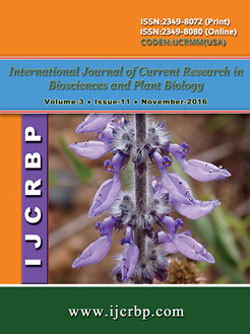 |
Online ISSN : 2349-8080 Issues : 12 per year Publisher : Excellent Publishers Email : editorinchiefijcrbp@gmail.com |
Current address: Department of Medical Laboratory Technology, College of Applied Medical Sciences, Jazan University, Saudi Arabia. Postal code: 82621/7431-P.O. Box: 2349
Permanent address: Evaluation of Natural Resources Department, Environmental Studies and Research Institute, University of El-Sadat City, El-Sadat City, Sixth Zone, Egypt
This study aimed to evaluate the anti-diabetic effects of aqueous extract of karela fruits and camel milk compared to dibenol on the streptozotocin (STZ) induced diabetic rats by assaying liver and kidney functions. Forty-two male albino rats were divided into 7 equal groups. Group I were given normal feed and water, groups II and III received orally (75 ml/rat/day) camel milk and extract of karela (800 mg/kg) respectively. Intraperitoneal injection of STZ (60 mg/kg) was used for inducing diabetes mellitus in groups IV, V, VI and VII. Groups V, VI and VII treated orally with dibenol (5mg/kg), camel milk and extract of karela respectively for 30 days. Blood glucose levels for each rat were determined before STZ dosing and after 3, 10, 30 days of administration. Blood samples were collected at the end of the experiment for estimation blood glucose concentration as well as kidney and liver functions parameters. The glucose level was decreased in rats treated with aqueous extract of karela or camel milk. Moreover, the ALT, AST, ALP enzymes, urea, creatinine and uric acid were decreased. It could be concluded that either karela or camel milk have anti-hyperglycemic effects and may be used to manage diabetes mellitus.
